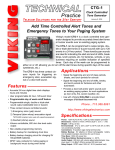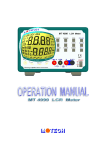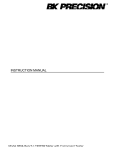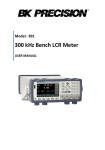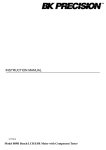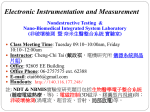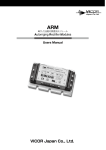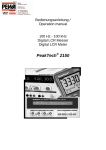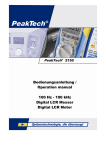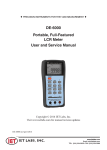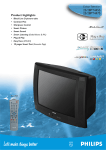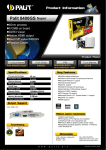Download MPT LCR01A/B Handheld LCR bridge meter User manual
Transcript
MPT LCR01A/B Handheld LCR bridge meter User manual Featured: 1. Adapt DSP technology to achieve fast measuring speed, high accuracy and high reliability.Measuring frequency can be set at 100K/10K/1K/120/100/20 Hz (LCR01A) or 1M/500K/100K/10K/1K/100Hz(LCR01B)。 2. Measuring parameter:Main parameter Z,Lp,Ls,Cp,Cs,DCR and subparameter ESR,D,Q,θ can be displayed in any combination. Contents 1. 1.1. 1.2. 1.3. 1.4. 2. 2.1. 2.2. 2.3. 2.4. 2.5. 2.6. 2.7. 2.8. 2.9. 2.10. 2.11. 3. MPT LCR01A/B Introduction Function introduction Impedance definition Accuracy and specification Accessory Manual illustration Panel Power Open/Short calibration Display speed Relative mode Manual range operation DC impedance measurement AC impedance measurement Capacitance measurement Inductance measurement Accessory operated illustration Usage illustration Maintain illustration Notice Cable connection technique 3.1. 3.2. Appendix 1 Appendix Open/Short circuit compensation 2 Appendix Serial/Parallel mode selection 3 Page 2 2 3 5 13 14 14 15 17 18 18 18 18 19 19 20 21 24 24 24 25 33 35 1 1. MPT LCR01A/B Introduction 1.1. Function introduction: MPT LCR01A/B is an innovative AC/DC impedance meter,also include capacitance and inductance measurement。It differ from traditional meter,MPT LCR01A/B adapts DSP(Digital Signal Process) technique,Technicians and engineers will get various conveniences from this advanced meter。 Features of MPT LCR01A/B: ●Frequency:100K/10K/1K/120/100/20 Hz(LCR01A) :1M/500K/100K/10K/1K/100Hz(LCR01B) ●Level:1Vrms/0.25Vrms/0.05Vrms/1.25Vdc(LCR01A) :0.6Vrms/0.25Vrms/0.05Vrms/0.6Vdc(LCR01B) ● Measuring Parameter:Z,Lp,Ls,Cp,Cs,DCR, ESR,D,Q,θ ● Basic accuracy:0.2%(=<10KHz),0.4%(100KHz) ,1%(500KHz),2%(1MHz) ● Dual LCD display ● DSP fast measuring ● Auto range/Range hold ● Open/Short compensation ● Display parameters: :Impedance Z DCR :DC Resistance :Inductance parallel Lp :Inductance series Ls :Capacitance parallel Cp :Capacitance series Cs θ :Impedance phase angle : Effective Series Resistance ESR :Dissipation factor D :Quality factor Q ● Display assembly: Serial mode: Z-θ , Z-ESR Cs-D , Cs-Q , Z-D , Cs-θ , Z-Q , Cs-ESR 2 Ls-D , Ls-Q , Ls-θ Parallel mode: Cp-D Lp-D , Cp-Q , Lp-Q , Cp-θ , Lp-θ , Ls-ESR 1.2. Impedance parameter definition According to the different measuring signal of impedance meter,It can be separated DC and AC impedance meter。The popular multimeter in market is a DC resistance meter;The MPT LCR01A/B is an AC/DC impedance meter。For electronic Circuit, component and material,impedance is an important parameter。 In engineering,vector is used to express impedance,It analysed real part Resistance(R) and imagine part reactance(X) ; And the polar express impedance(Magnitude) and Theta(Phase)。Diagrams below show the relation。 3 Imaginary Axis Xs Z(Rs , Xs) ∣Z∣ θ Real Axis Rs 圖 一 Z = Rs+jXs =∣Z∣∠θ(Ω) Rs =∣Z∣Cosθ ∣Z∣= Xs =∣Z∣Sinθ θ Rs 2 + Xs 2 = Tan -1 (Xs/Rs) Z:Impedance Rs:Resistance Xs:Reactance Ω:Unit Ohm 4 Reactance can be separated as(Inductive) XL and(Capacitive) XC。The definition as: XL =ωL=2πfL and XC =(ωC) -1 =(2πfC) -1 L:Inductance (H) C:Capacitance (F) f:Frequency (Hz) Additional,other parameters are attached to passive component,Quality factor(Q) and Dissipation Factor(D)。Both are defined the purity of reactance,that is the energy storage(reactance) and the energy consumption(resistance)ratio,defined as follow: Q=D -1 = (tanδ) -1 =∣Xs∣.Rs-1=ω.Ls.Rs-1=(ω.Cs.Rs) -1 =∣B∣.G-1 = Rp.∣Xs∣-1=Rp.(ω.Lp) -1=ω.Cp.Rp Quality factor is applied on inductive components,and Dissipation factor is applied on capacitive components。Both are reciprocal each other。 Traditional,component can be analysed as series equivalent and parallel equivalent。 Both defined as follow。 Series connection parallel connection 1.3. Specification and Accuracy 5 ●LCD display: parameter Range Z 0.000Ω ~ 9999MΩ L 0.000μH ~ 9999H(LCR01A) 0.0xxnH ~ 9999H(LCR01B) C 0.000pF ~ 9999F DCR 0.000Ω ~ 9999MΩ ESR 0.000Ω ~ 9999Ω D 0.000 ~ 9999 Q 0.000 ~ 9999 Θ ﹣180.0° ~ 180.0° ●Accuracy(Ae) : 750K ∫ 100K (Ω) 100K ∫ 20K (Ω) 20K ∫ 10 (Ω) 2% ± 1% ± 0.5% ±1 1 20Hz(LCR01A)/100Hz 1* 0.2% ±1 0.2% ±1 5% ± 2% ± 0.4% 1* 1 ±1 0.4% ±1 Ae Freq. ∣Zx∣ 20M ∫ 10M (Ω) 10M ∫ 750K (Ω) DCR 10 ∫ 1 (Ω) 1 ∫ 0.1 (Ω) 0.5% ± 1 1% ± 1 * * 2%±1* 5% ± 1 120Hz(LCR01A) 1KHz 10KHz 5% ± 2% ± 1* 1 100KHz UnD 500KHz (LCR01B) UnD 1MHz (LCR01B) UnD UnD UnD 10% ±1 5% ± 1% ± 5%±1* 1 1 UnD 10% ±1 * 10% ± 1 * 2% ± 10% ± 1 20% * 1 ±1* Accuracy show above is true when 1Vrms measuring level used。 Ae X 1.25 if 250mVrms measuring level used 。 Ae X 1.50 if 50mVrms measuring level used 。 6 measuring L and C,if Dx>0.1, then Ae X (1+Dx2)。 Measuring ESR,if Qx>0.1, then Ae X (1+Qx2) 。 * Measuring level set to 50mV, Ae undefined。 Z accuracy C accuracy :shown on table 1. : ∣Zx∣=(2.π.f.Cx) -1 (Ω) CAe=Ae of ∣Zx∣ f:frequency(Hz) Cx:The measured capacitance(F) ∣Zx∣:The measured impedance(Ω) Above accuracy is true when Dx<0.1,if D x>0.1then CAe X (1+Dx2)。 Example:C accuracy calculate Measuring condition: Frequency:1KHz Level:1Vrms Speed:Slow Capacitance under test:100nF Then ∣Zx∣=(2.π.f.Cx) -1 ∣Zx∣=(2.π.103.100.10-9) -1=1590 (Ω) look up on table 1: CAe=±0.2 (%) 7 L accuracy : ∣Zx∣=2.π.f.L (Ω) LAe=Ae of ∣Zx∣ f:Frequency(Hz) Lx:The measured inductance(H) ∣Zx∣:The measured impedance(Ω) Above accuracy is true when Dx<0.1,if D x>0.1 then CAe X (1+Dx2) 。 Example:L accuracy calculation Measuring condition: Frequency:1KHz Level:1Vrms Speed:Slow Inductance under test:1mH then ∣Zx∣=2.π.f.Lx ∣Zx∣=2.π.103.10-3=6.283 (Ω) look up on table 1: LAe=±0.5 (%) 8 ESR accuracy : ±Xx.Ae. 100-1 (Ω) Xx=2.π.f.Lx=(2.π.f.Cx) -1 f:Frequency(Hz) Xx:The measured impedance(Ω) Lx:The measured inductance(H) Cx:The measured capacitance(F) Above accuracy is true when Dx<0.1。 Example:Cs-ESR accuracy calculation Measuring condition: Frequency:1KHz Level:1Vrms Speed:Slow Capacitance under test:100nF then ∣Zx∣=Xx=(2.π.f.Cx) -1 ∣Zx∣=(2.π.103.100.10-9) -1=1590 (Ω) look up on table 1: CAe=±0.2 (%) ESR A e=±Xx.Ae/100 = ±1590 X 0. 2 / 100 = ± 3.18 (Ω) 9 D accuracy : De=±A e /100 Above accuracy is true when Dx<0.1,if D x>0.then CAe X (1+Dx)。 Example:C-D accuracy calculation Measuring condition: Frequency:1KHz Level:1Vrms Speed:Slow Capacitance under test:100nF then ∣Zx∣= (2.π.f.Cx) -1 ∣Zx∣=(2.π.103.100.10-9) -1=1590 (Ω) look up on table 1: CAe=±0.2 (%) D A e= ±CAe /100 = ±0.2/100= ±0.002 10 Q accuracy : Qe=±(Qx2.De)/(1 Qx.De) Qx:The measured Q value。 De:relative D accuracy。 Above accuracy is true when Qx.De<1。 Example:C-Q accuracy calculation Measuring condition: Frequency:1KHz Level:1Vrms Speed:Slow Inductance under test:1mH then ∣Zx∣=2.π.f.Lx ∣Zx∣=2.π.103.10 -3=6. 283 (Ω) look up on table 1: LAe=±0.5 (%) De=±Ae/100=±0.005 If the measured Qx=20 QAe=±(Qx2.De/(1 Qx.De) )=± ( 2/(1 0.1) ) 11 Θ accuracy : θe= (180/π)/(Ae/100) (Deg) Example:Z-θaccuracy calculation Measuring condition: Frequency:1KHz Level:1Vrms Speed:Slow Capacitance under test:100nF then ∣Zx∣=(2.π.f.Cx) -1 ∣Zx∣=1/(2.π.103.100.10 -9)=1590 (Ω) look up on table 1: ZAe=±0.2 (%) θAe=±(180/π)/(ZAe/100)=±0.115 (Deg) 12 ●measuring signal: Level accuracy:10% Frequency accuracy:0.01% ●Output impedance:100Ω±5% ●Measuring speed:depend on frequency Fast:5times/second(10KHz) Slow:2.5times/second(10KHz) ●Power low notify: Input or battery power lower than 6.2Volt ●Battery: Charge current:about 18mA Battery type:Ni-Mh Life:3.0 hr(LCR01A) ,1.5 hr(LCR01B) ●Adapter: Input:110V/220Vac 50/60Hz Output:12Vdc ●Operation environment: Temperature:0℃ to 40℃ (operation) -20℃ to 70℃ (storage) Humidity:≦85% R.H. at 40℃ Size:178mm × 86 mm × 45mm 7"× 3.4"× 1.8" (L×W×H) Weight:300g 13 1.4. Accessory ●LCR01A/B Operation manual ●LCR01A or LCR01B one set ●Ni-Mh rechargeable battery ●Shorted Bar ●5 wire/0.75mSMD test probe ●5 wire/0.75m Kelvin Clips test cable ●AC power adaptor 14 2. 1. 2. 3. 4. 5. 6. 7. 8. 9. 10. User operate illustration 2.1. Panel: Main parameter display LCD Low voltage indicator Machine type Level switch button Frequency switch button Display speed switch Button Z/DCR/C/L display switch button Hpot/Hcur terminal Lpot/Lcur terminal Battery house 11. 12. 13. 14. 15. 16. 17. 18. Subparameter display LCD Power ON/OFF switch Open/Short calibration button Relative mode button Θ/D/Q/ESR display switch button Auto/Range hold switch button Guard terminal Power adaptor input hole 15 2.2. Power: ●Battery supply Remove battery cup,clean battery house,put the pull-up tape under battery and put battery into the battery house in proper direction,then put on the battery cup 。 If the battery is not chargeable , remove the power adaptor input connector;If the battery is chargeable,power adaptor input connector can be plug-in。 16 ●Power adaptor supply If battery not available,It can be powered by power adaptor。If the power adaptor is plug-in and the power switch on LCR01A/B is off,It will charge battery on battery house。 17 2.3. Open/Short calibration: LCR01A/B function with Open/Short calibration to meet the measuring of High/Low impedance measurement。 ●Open calibration Clean the measuring terminal,make it on open state,press【CAL】button about 1 second,main parameter will display「CALO」and a “bi" sound will be heard,Calibration time will depend on measuring frequency,the high frequency,the lower calibration time needed;After calibration, a “bi" sound will be heard again。 ●Short calibration Plug-in shorted bar first,press【CAL】about 2 seconds,till「CALS」shown on main display,and a “bi" sound will be heard;After calibration, a “bi" sound will be heard again。 18 2.4. ●Display refresh: LCR01A/B functions with Fast/Slow display refresh mode,User press the 【Speed】button will toggle speed mode。on『Fast』mode,the refresh speed will be twice of『Slow』mode,the more of the measuring frequency, the faster of the refresh speed。 2.5. ●Relative mode LCR01A/B functions with measuring relative mode,user put a reference component on the test terminals。Then press 【Relative】button。And remove this reference component from the test terminals,put other device under test on test terminals then,the main LCD display will display the result of subtraction of the reference value from the measuring one。 2.6. ●Range hold mode LCR01A/B functions with autorange/range_hold mode,put a reference component on the test terminals,then wait until display stable,press【Range Hold】button。 『RH』 will be shown on sub-parameter display LCD,LCR01A will set this measuring range。Remove this reference component and put other component under test on test terminals,the measured result will gotten faster。But care should be taken,the measured range should in the range 2 and 1/2 of the reference value。 2.7. ●DC impedance measuring Press【L/C/Z/DCR】 ,till 『DCR』 shown on main parameter display LCD,then LCR01A/B will be in the DC impedance measuring mode。 19 2.8. ●AC impedance measuring Press【L/C/Z/DCR】 ,till『Z』shown on main parameter display LCD,then LCR01A/B will be in the AC impedance measuring mode。 2.9. ●Capacitance measuring Depend on component equivalent,Capacitance measuring can be separated as(Cs,Serial Mode) and (Cp,Parallel Mode),user can press【L/C/Z/DCR】button as they need。If 『Cs』mode selected,then press button【θ/D/Q/ESR】select one of the fourθ/D/Q/ESR sub-parameter。If『Cp』mode selected,then press button【θ/D/Q/ESR】select one of the threeθ/D/Q sub-parameter。 20 2.10. ●Inductance measuring Inductance measuring can be separated as(Ls,Serial Mode) and (Lp,Parallel Mode),user can press【L/C/Z/DCR】button as they need。If『Ls』mode selected,then press button 【θ/D/Q/ESR】select one of the fourθ/D/Q/ESR sub-parameter。If『Lp』mode selected, then press button【θ/D/Q/ESR】select one of the threeθ/D/Q sub-parameter。。 21 22 2.11. ●Accessory operation To insure measuring accuracy and stable,perform「LOCK」action when test probe been used。 Shorted Bar 23 SMD Test Probe 24 Kelvin Clip Test Probe 25 3. Use noted 3.1. Service information MPT warrants to the original purchaser that its products and the component thereof ,will be free from defects in workmanship and materials for a period of one year from date of purchase。 3.2. Items notes ●Don't open the device case beside battery cap。 ●Keep measuring terminals clean to insure measuring accuracy。 ●During measuring,keep hands away form device above 10cm。 ●Discharge capacitor before measuring。 ●When low voltage alarm,then replace battery or charge with adaptor。 ●Remove battery if long period don't use。 26 Appendix Cable connection technique 一 Auto-balancing Bridge has four terminals(Hcur、Hpot、Lcur、and Lpot)to connect the device under test(DUT).It is important to understand what connection method will affect the measurement accuracy。 Two terminal(2T)is the simplest way to connect the DUT,but it contents many errors which are the inductor and resistor as well as the parasitic capacitor of the test leads(figure 1)。Due to these errors in measurement,The effective impedance measurement range will be limit at 100Ωto 10KΩ。 27 Ro HCUR A ● ● Lo ● HPOT D U T V Co D U T LPOT ● ● LCUR ● Ro Lo 2T Impe Ω 1m 10m 100m 1 10 100 1K 10K 100K 1M 10M Figure 1. 28 3-Terminals(3T) uses coaxial cable to reduce the effect of the parasitic capacitor,the shield of the coaxial cable should be connect to Guard of the instrument to increase the measurement range up to 10 MΩ。 Ro HCUR ● ● Lo A ● HPOT D U T V Co D U T LPOT ● ● LCUR ● ● Ro Lo Co no effect on test result Figure 2. 29 ● A D U T V ● ● 2-T with shielding 3T impe Ω 1m 10m 100m 1 10 100 1K 10K 100K 1M 10M Figure 2 (continued) 30 4-Terminal(4T)connection reduces the effect of the test lead resistance,this connection can improve the measurement range down to 10mΩ。However,the inductance of the test lead can not be eliminated。 HCUR A HPOT ● D U T V D U T LPOT ● LCUR 4T Impe Ω 1m 10m 100m 1 10 100 1K 10K 100K 1M 10M Figure 3. 31 5-Terminal connection is the combination of 3T and 4T。It has four coaxial cable。Due to the advantage of 3T and 4T,this connection can widely increase the measurement range for 10mΩ to 10MΩ。 HCUR A ● HPOT ● D U T D U T V LPOT ● LCUR 5T Impe Ω 1m 10m 100m 1 10 100 1K 10K 100K 1M 10M 32 ● A ● V D U T ● Wrong connection of 4T Figure 4. 4-terminal path(4TP) connection solves the problem that caused by the test lead inductance。4TP uses four coaxial cables to isolate the current path and the voltage sense cable。The return current will flow through the coaxial cable as well as the shield 。Therefore,the magnetic flux that generated by internal conductor will cancel out the magnetic flux generated by external conductor(shield)。The 4TP increase the measurement range from 1mΩ to 10MΩ。 33 HCUR A ● HPOT ● D U T D U T V LPOT ● LCUR 5T Impe Ω 1m 10m 100m 1 10 100 1K 10K 100K 1M 10M 34 HCUR ● HPOT V D U T D U T ● LPOT LCUR A 4T Impe Ω 1m 10m 100m 1 10 100 1K 10K 100K 1M 10M 35 Eliminating the effect of the parasitic capacitor When measuring the high impedance component(i.e. low capacitor),the parasitic capacitance becomes an important issue(Figure 3.6)。In figure 3.6(a),the parasitic capacitor Cd is paralleled to DUT as well as Ci and Ch,To correct this problem。Add a guard plane(Figure 3.6b) in between H and L terminals to break the Cd。If the guard plane is connected to instrument guard,The effect of Ci and Ch is removed。 Ch HCUR HPOT Cd D U T LPOT LCUR Cl Ground contact Parastic effect HCUR HPOT Guard plant D U T LPOT LCUR contact Guard plant reduces parastic effect 36 Append Open/Short compensation 2 For those precision impedance measuring instrument,the open and short compensation need to be used to reduce the parasitic effect of the test fixture。The parasitic effect of the test fixture can be treated like the simple passive components in figure 3.7a。When the DUT is open,the instrument gets the conductance Yp=Gp+jwCp(Figure 3.7b) 。When the DUT is short,the instrument gets the impedance Zs=Rs+jwLs(Figure 3.7c)。After open and short compensation,Yp and Zs are for calculating the real Zdut(Figure 3.7d)。 Parastic of test fixture Redundant Zs HCUR Rs ● Parastic Yo Ls ● ● HPOT Zm Co Go D U T LPOT ● ● ● LCUR Parastic effect of test fixture 37 HCUR Rs Ls ● ● ● HPOT Yo Co Go OPEN LPOT ● ● ● LCUR Yo=Go+jωCo Rs+jω«(Go+jωCo)-1 Open ckt HCUR Rs ● Ls ● HPOT ● ● Zs Co Go SHORT LPOT ● ● ● LCUR Zs=Rs+jωLs Short ckt Zs ● Yo Zm Zdut Zdut = Zm-Zs 1-(Zm-Zs)Yo ● 38 Appendi Selecting the series or parallel mode x3 According to different measuring requirement,there are series and parallel modes to describe the measurement result。It is depending on the high or low impedance value to decide what mode to be used。 ●capacitor The impedance and capacitance in the capacitor are negatively proportional。 Therefore,the large capacitor means the low impedance;the small capacitor means the high impedance。Figure below shows the equivalent circuit of capacitor。If the capacitor is small,the Rp is more important than the Rs。If the capacitor is large, the Rs shouldn't be avoided。Hence,uses parallel mode to measure low capacitor and series mode to measure high capacitor。 Small C C Large C Rp effect Rs no effect C Rp no effect Rs effect 39 ●Inductor The impedance and inductive in the inductor are positively proportional。Therefore,the large inductor equals to the high impedance and vice versa。Figure below shows the equivalent circuit of inductor。If the inductor is small,the Rs is more important than Rp, If the inductor is large,The Rp should be taking care of。So,uses series mode to measure low inductor and parallel mode to measure high inductor。 Small Large L L Rp effect L L Rp no effect Rs no effect Rs effect According to analysis above: 1. Impedance below 10Ω,series mode selected。 2. Impedance above 10KΩ,parallel mode selected。 3. Between 10Ω and 10KΩ depend on needed。 Example: DUT=100pF Freq.=10KHz Z=159.2KΩ parallel mode selected。 Example: DUT=100μΗ Freq.=10KHz Z=6.2832Ω Serial mode selected。 C. Accuracy: 40 20Hz 100Hz 120Hz 1KHz 10KHz 795.5 μF 795.5 μF ∫ 7.955 mF 7.955 mF ∫ 79.55 mF 0.5%±1 0.2%±1 0.5%±1 1%±1 159.1 pF ∫ 2.121 nF 1.212 nF ∫ 15.91 nF 15.91 nF ∫ 159.1 μF ∫ 159.1 μF 1591 μF 1591 μF ∫ 15.91mF 2%±1 1%±1 0.5%±1 0.2%±1 0.5%±1 1%±1 66.31pF ∫ 132.6pF 132.6pF ∫ 1.768nF 1.768nF ∫ 13. 26nF 13.26nF ∫ 132. 6μF ∫ 132. 6μF 1326μF 1326μF ∫ 13.26mF 2%±1 1%±1 0.5%±1 0.2%±1 0.5%±1 1%±1 7. 957 pF ∫ 15.91 pF 15.91 pF ∫ 212.1 pF 212.1 pF ∫ 1.591 nF 1.591 nF ∫ 15.91 μF ∫ 15.91 μF 159.1 μF 159.1 μF ∫ 1.591 mF 2%±1 1%±1 0.5%±1 0.2%±1 0.5%±1 1%±1 0. 795 pF ∫ 1.591 pF 1.591 pF ∫ 21.21 pF 21.21 pF ∫ 159.1 pF 159.1 pF ∫ 1.591 μF ∫ 15.91 μF ∫ 1.591 μF 15.91 μF 159.1 μF 5%±1 2%±1 0.5%±1 0.2%±1 0.5%±1 1%±1 0.159 pF ∫ 2.121 pF 2.121 pF ∫ 15.91 pF 15.91 pF ∫ 159.1 nF 159.1 nF ∫ 1.591 μF ∫ 1.591 μF 15.91 μF 5%±1 2%±1 0.4%±1 2%±1 5%±1 0.159 pF ∫ 2.121 pF 2.121 pF ∫ 15.91 pF 15.91 pF ∫ 31.91 nF 31.91 nF ∫ 319.1 nF 319.1 n F ∫ 10%±1 5%±1 1%±1 5%±1 10%±1 0.079 pF ∫ 1.111 pF 1.111 pF ∫ 7.999 pF 7.999 pF ∫ 15.91 nF 15.91 nF ∫ 159.1 nF 159.1 nF ∫ 1.591 μF 20% 10%±1 2%±1 10%±1 20%±1 398 pF ∫ 795.5 pF 795.5 pF ∫ 10.6 nF 10.6 nF ∫ 79.55 nF 2%±1 1%±1 79.57 pF ∫ 159.1 pF 100KHz NA NA 500KHz NA NA 1MHz NA NA 79.55 nF ∫ 3.191 μF 41 L Accuracy: 20Hz 100Hz 120Hz 1KHz 10KHz 100KHz 159.3 KH ∫ 79.55 KH 79.55 KH ∫ 5965 H 5965 H ∫ 795.5 H 795.5 H ∫ 79.55 mH 79.55 mH ∫ 7.955 mH 7.955 mH ∫ 2%±1 1%±1 0.5%±1 0.2%±1 0.5%±1 1%±1 31.83 KH ∫ 15.91 KH 15.91 KH ∫ 1193H 1193H ∫ 159. 1 H 159. 1 H ∫ 15. 91 mH 15. 91 mH ∫ 1.5 91 mH 1.591 mH ∫ 2%±1 1%±1 0.5%±1 0.2%±1 0.5%±1 1%±1 26.52KH ∫ 13. 26KH 13. 26KH ∫ 995H 995H ∫ 132. 6H 132. 6H ∫ 13. 26mH 13. 26mH ∫ 1.326mH 1.326mH ∫ 132. 6μH 2%±1 1%±1 0.5%±1 0.2%±1 0.5%±1 1%±1 31. 83 KH ∫ 1. 591 KH 1. 591 KH ∫ 119.3 H 119.3 H ∫ 15. 91 H 15. 91 H ∫ 1. 591 mH 1. 591 mH ∫ 159.1 μH ∫ 159.1 μH 15. 91 μH 2%±1 1%±1 0.5%±1 0.2%±1 0.5%±1 1%±1 11.93H ∫ 1. 591 H 1. 591 H ∫ 159. 1 μH ∫ 15.91 μH ∫ 159. 1 μH 15.91 μH 1. 591 μH 318.3H ∫ 159. 1 H 159. 1 H ∫ 11.93H 79.55 μH 159. 1μH 5%±1 2%±1 0.5%±1 0.2%±1 0.5%±1 1%±1 31. 83 H ∫ 15. 91 H 15. 91 H ∫ 1.193 H 1. 193H ∫ 159. 1 mH 159. 1 mH ∫ 15.91 μH ∫ 1.591 μH ∫ 15. 91 μH 1. 591 μH 0. 159 μH 5%±1 2%±1 0.4%±1 2%±1 5%±1 32.26 mH ∫ 6.363 mH 6.363 mH ∫ 3.181 μH ∫ 3.181 μH 0.318 μH 0.031 μH 1%±1 5%±1 10%±1 3.181 mH ∫ 1.591 μH ∫ 0.159 μH ∫ 1.591 μH 0.159 μH 0. 015 μH 2%±1 10%±1 20%±1 NA 500KHz NA NA NA NA 5%±1 1MHz NA NA 16.13 mH ∫ 3.181 mH NA NA 10%±1 0.318 μH ∫ 42 D Accuracy: ∣Zx∣ 20M ∫ 10M (Ω) 10M ∫ 750K (Ω) 750K ∫ 100K (Ω) 100K ∫ 10 (Ω) 10 ∫ 1 (Ω) 1 ∫ 0.1 (Ω) ±0.020 ±0.010 ±0.005 ±0.002 ±0.005 ±0.010 Freq. 20Hz 100Hz 120Hz 1KHz 10KHz ±0.050 ±0.020 100KHz NA ±0.050 ±0.020 ±0.004 ±0.020 ±0.050 500KHz NA NA NA ±0.01 ±0.050 ±0.10 1MHz NA NA NA ±0.02 ±0.10 ±0.200 Θ Accuracy: ∣Zx∣ 20M ∫ 10M (Ω) 10M ∫ 750K (Ω) 750K ∫ 100K (Ω) 100K ∫ 10 (Ω) 10 ∫ 1 (Ω) 1 ∫ 0.1 (Ω) ±1.046 ±0.523 ±0.216 ±0.105 ±0.261 ±0.523 Freq. 20Hz 100Hz 120Hz 1KHz 10KHz ±2.615 ±1.046 100KHz NA ±2.615 ±1.046 ±0.209 ±1.046 ±2.615 500KHz NA NA NA ±1.001 ±5.005 ±10.01 1MHz NA NA NA ±2.001 ±10.01 ±20.01 43 Minpu Technology CO,. LTD Address:5F,NO.4,Lane123,SinTai RD,Sinjuhung Taipei county Taiwan Tel:(02)2998-8395 Fax:(02)2998-2810 44













































